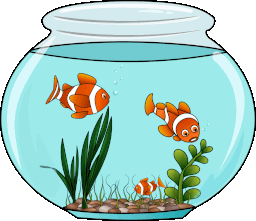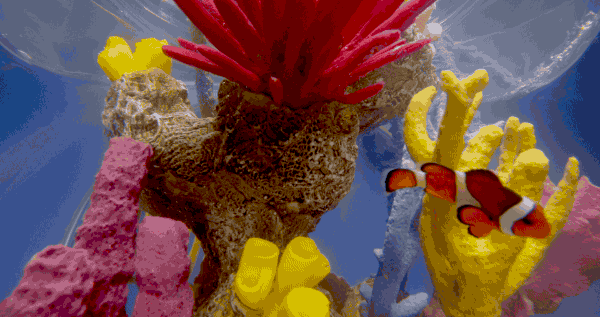Recognizing Aquarium Fish Behavior: How to Tell If Your Fish Are Happy or Sad
Understanding your aquarium fish’s emotions is crucial for their well-being. This guide highlights key behaviours that indicate happiness and sadness in your fish tank. Learn to recognize the signs in your live fish and discover tips for creating a thriving aquarium tank environment. Enhance your aquatic friends' quality of life with essential care advice and the best practices for fish care.
Table of Contents
-
1. Signals of Happy Aquarium Fish
2. Signs of Sad or Stressed Aquarium Fish
3. Tips for a Happy Aquarium Environment Creation
- Maintain Water Quality
- Provide Hiding Places
- Choose Tank Mates Compatible
- Diet: Provide a Well-Balanced Diet
- Stress Reduction
- 4. Common Signs of Health Problems
- 5. FAQs
- 6. Conclusion
1. Signs of Happy Aquarium Fish:
Active Swimming:
Happy fish tank fish swim actively. They'll look at all corners of the fish tank, showing curiosity about their surroundings. If the fishes are happy and content, they would be swimming about; investigating plants as well as finding openings in decorations to swim through. This search behaviour is important for psychological stimulation, because it mimics natural behaviour. If the freshwater fish spend all their time patrolling the tank and interacting with their surroundings, they feel secure and comfortable. Adding plants and structures that create some areas of hiding will provide a sense of security for active swimming to the fish.
Bright Colors:
Bright coloration is a sign of healthy and joyful aquarium fish. Stress or illness can cause the colors of stressed or sick fish to fade. A fish which appears to show bright colours is said to be a healthy one as well as being not under any form of stress. For instance, tropical fish like bettas and guppies always have stunning and vibrant colors that are a pleasure to view when the fish are thriving. Monitor the colors of your fishes; sudden changes can signal several problems. When the color dulls, it may be a sign of some internal diseases, stress, or poor water quality. Providing a well-maintained fish tank with the right parameters will help keep your fish looking their best.Schooling behaviour:
A number of species of fish can be kept in schools. Many contented fish are naturally schooling because they swim close together; this behaviour would normally be interpreted as an indication of security, and therefore comfort, with their surroundings. This is particularly true of fish like tetras and barbs, which are safest when they are with other fish of the same kind. Being in the company of their own species can provide them with social interaction, reduce stress, and enhance their overall well-being.This is an indication of comfort by your aquarium fish as they present that they are safe and secure in their environment. For schooling species, there is a need to ensure that enough of the species is kept in the tank to avoid stress and loneliness as a result of their few schoolmates. There should be adequate research on appropriate species since aggression may hinder harmony in the aquarium tank.

Healthy Eating Habits:
A contented fish will have a good appetite and welcome food. If the fish tank fish get excited and fight for food during feeding times then that is an indication that they are satisfied. The way your fish respond to feeding time is a good way of ascertaining their well-being. If your fish are swimming actively and even jumping or looking up to the surface in search of food then that means they are doing great.To remain healthy, there is a need to ensure that fish are given the best food suited to their needs and requirements. For instance, some fish require food with a high protein content while others prefer a plant-based diet. It is through research into the specific demands of your freshwater fish or tropical fish that ensure your fishes meet the nutrition that will keep them happy and healthy.
Curiosity and Adventure:
Curious fish will come and investigate new objects or a change in their environment. Happy fish tank fish often tend to be playful, swimming through plants or chasing each other. This play interaction is important for their mental balance because it is similar to what they would do naturally in the wild. Adding new decorations or changing the layout of your home aquarium can stimulate their curiosity and promote exploration. Use natural decorations like driftwood and live plants to create a dynamic environment that encourages fish to engage with their surroundings.Signs of Sad or Stressed Aquarium Fish:
Latent or Coma:
If your live fish hide most of the time or just lie still at the bottom of the fish tank, then the sign may be stress or unhappiness. Sometimes, it is quite normal to hide, but extreme lethargy can signal a problem. For instance, when your fish stay indoors for a long time and don't want to swim whenever the tank is approached, it may mean they do not like where they are. Overcrowding, aggressive tankmates, or some alterations in water quality can be common causes of stress. Monitoring the behaviours of the fish and keeping the tank conditions optimal help to control these problems.Numb Shades:
When a fish is stressed or ill, it can often lose some of its color. A pale-looking fish may be a sign of sickness or discomfort. Dull coloration may indicate low water quality, aggression in tank mates, or even illness.Monitoring the coloration of your fish may help to pinpoint issues early. Where there seems to be a sudden change, identify potential causes and make the relevant changes such as improving water conditions or isolating aggressive fish.
Hostility or Alienation:
Unhappy fish may display aggression towards tank mates or isolate themselves from the group. This behaviour can be caused by stress, overcrowding, or territorial disputes. For instance, some fish may become territorial when they feel their space is threatened, leading to aggressive interactions.Observe the interaction of fishes and change their tank mates if necessary. If some fish are constantly bullied, separate them or increase the number of hiding places to reduce pressure and aggression.
Refusal to feed:
Lack of appetite can be an indicator that your pet fish are stressed and unhappy. Loss of appetite in aquatic animals may indicate that they are disconnected from their tank mates or have a quality problem in the water. If you suspect this is so, just check your parameters to ensure everything's on point according to the specific requirements of your fish species. You may also think if there were any recent changes in the conditions around the tank that would have been stressing them out unnecessarily.Anomalous Swimming Patterns:
Strange swimming behaviours - like excessive circling, darting, or rubbing against objects - can indicate stress or health issues. For example, fish that swim erratically may be experiencing discomfort due to poor water quality or illness.Caution on the changes of swimming habits might be symptoms of a problem that needs action. When you notice abnormal patterns, check the conditions about your tank thoroughly and possibly visit an aquatic vet.
Tips for a Happy Aquarium Environment Creation
To make sure your fish enjoy great health, it is advisable to consider the following fish care tips:
Maintain Water Quality:
Regular testing and changing the water ensures that the water is clean, within the appropriate range of pH and temperature values and free of chemicals, hence safe for live fish. Water conditioners help in removing harmful chemicals. Investment in a good quality water testing kit will allow you to monitor key parameters such as ammonia, nitrite, and nitrate, which play an important role in the overall health of your aquarium tank. Regular water changes (10-20% weekly) will help maintain optimal conditions.Provide Hiding Places:
Add plants, rocks, and decorations to hide variously sized crevices so the fish can have their hiding spots. Adding such elements makes the fishes feel secured, comfortable, and less stressed.Adding different kinds of hiding places would benefit shyer species and exploratory ones. Think also of using live plants as they complement the improvement of the quality of water, with the oxygen that such plants produce making for a healthier environment.
Choose Tank Mates Compatible:
Research fish types to ensure compatibility and avoid aggression. Some species are naturally more aggressive and may not coexist peacefully with others, so knowing which fish is best for aquarium setups is essential. Before adding new fish to your home aquarium, take the time to research each species' temperament and compatibility. This ensures that all your fish can coexist peacefully, promoting a harmonious environment.Diet: Provide a well-balanced diet.
Offer high-quality food suitable for the specific types of fish you keep, ensuring their nutritional needs are met. Consider rotating food types and including occasional treats to keep feeding interesting. This is crucial for identifying the best food for fish in aquarium setups.Each species of fish in a tank requires different types of diet. Studying the specific dietary requirements for your type of fish can help you maintain a proper balance, which is essential for optimal health and happiness of your fish.
Stress Reduction:
Avoid sudden changes in the environment, such as extreme water changes or loud noises. Regular feeding and maintenance practices help keep the fish feeling secure. A stable environment with consistent temperature, lighting, and feeding is required to minimize stress and allow your fish to grow. Identify health problems Beside monitoring of the behaviour, always consider the potential health problems that may occur in your home aquarium. The common signs include:Fins Clamped: If the fins are kept close to the bodies, it could be a sign of stress or illness.
White Spots or Lesions: Fungal spots or lesions on the fish may be an indication of ich or fin rot.
Increased Gilling: When your fish take too much time to gill, it indicates poor water quality or low oxygen levels. That is, regular check-ups and observations will help in the early diagnosis of health issues, ensuring timely interventions.
FAQ
1. How can I tell if my fish are happy?
Look for active swimming, bright colors, schooling behavior, a good appetite, and curiosity about their environment.
2. What signs indicate my fish are stressed?
Signs include hiding or lethargy, dull colors, aggression, loss of appetite, and abnormal swimming patterns.
3. How can I improve my fish's living conditions?
Maintain water quality, provide hiding spots, choose compatible tank mates, offer a balanced diet, and minimize stress.
4. What should I do if my fish show signs of stress?
Check water quality, isolate aggressive fish, improve tank conditions, and consult an aquatic vet if needed.
5. How often should I feed my fish?
Feed once or twice a day, providing only what they can eat in a few minutes.
6. Can fish get bored?
Yes, to prevent boredom, change the tank layout and add new decorations.
7. How can I tell if my fish are healthy?
Healthy fish are active, have bright colors, a good appetite, and interact normally with tank mates.
8. What if my fish refuse to eat?
Check water conditions, observe tank mates for aggression, review their diet, and consult a vet if it continues.
9. Why is water quality important?
Good water quality prevents stress and illness, ensuring a healthy aquarium environment.















